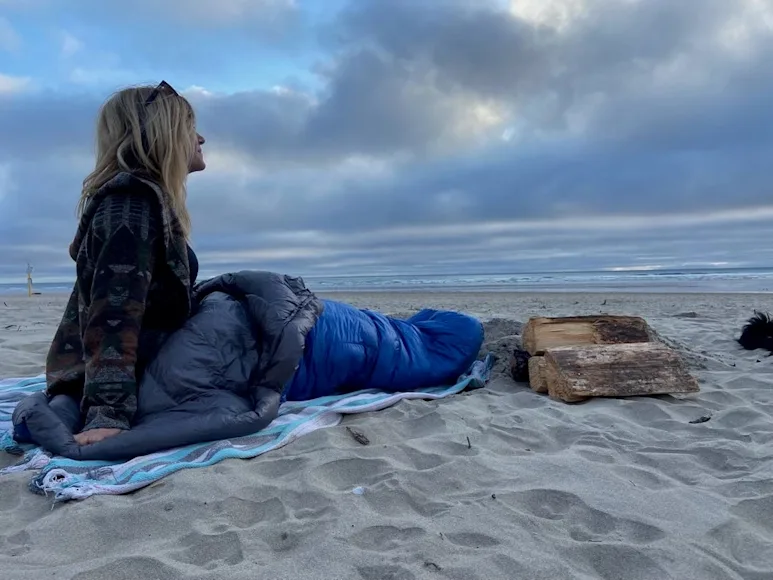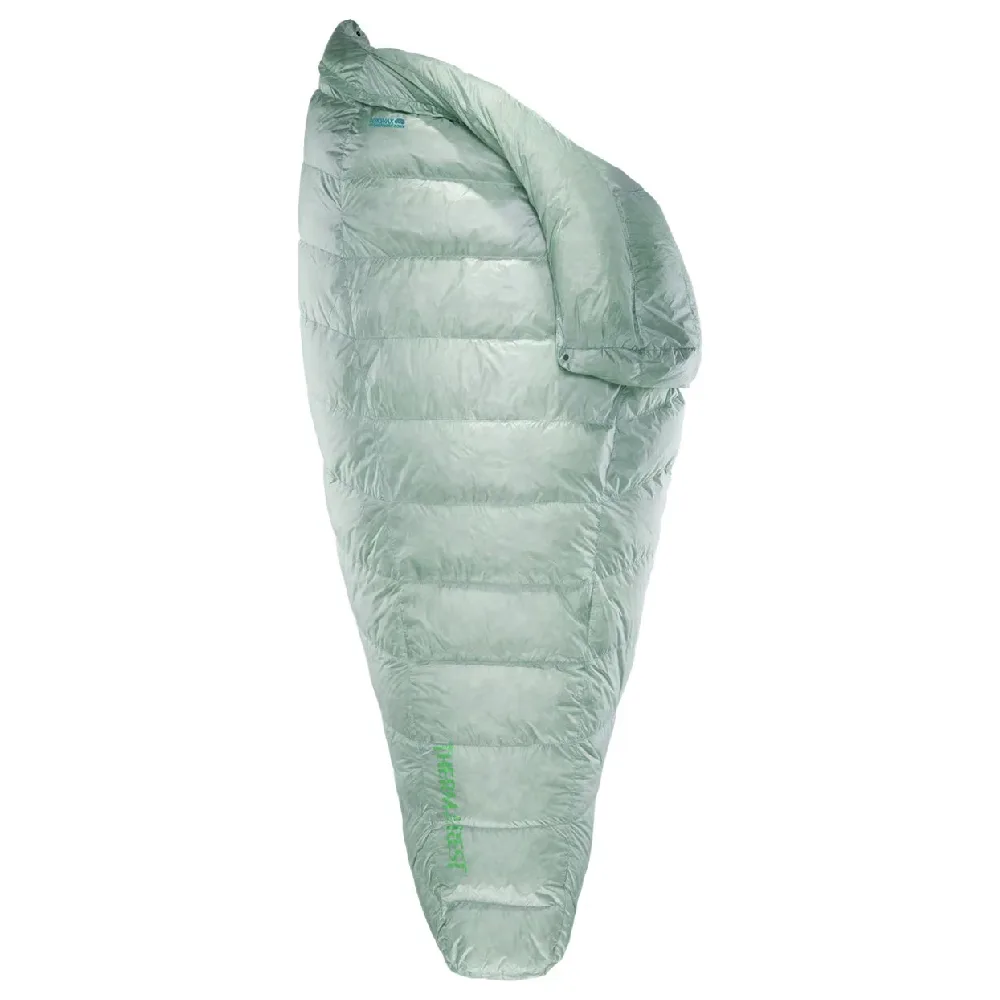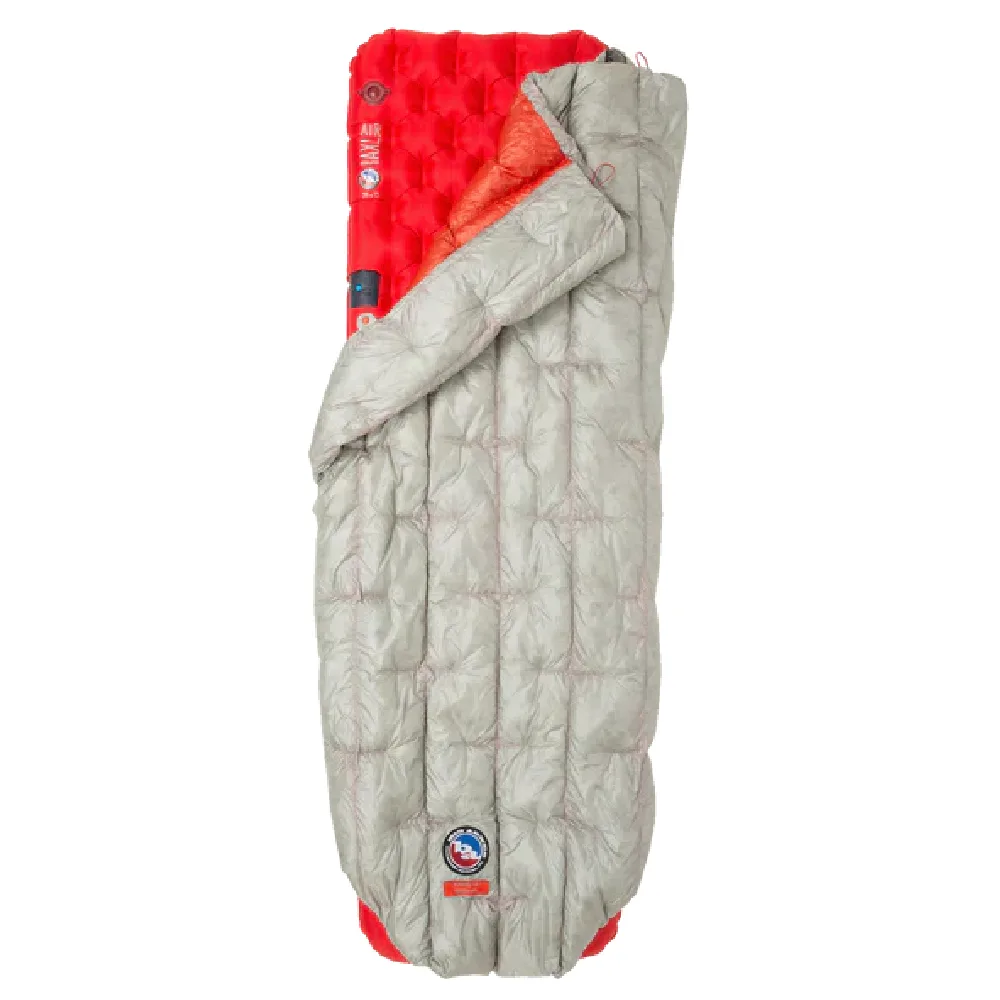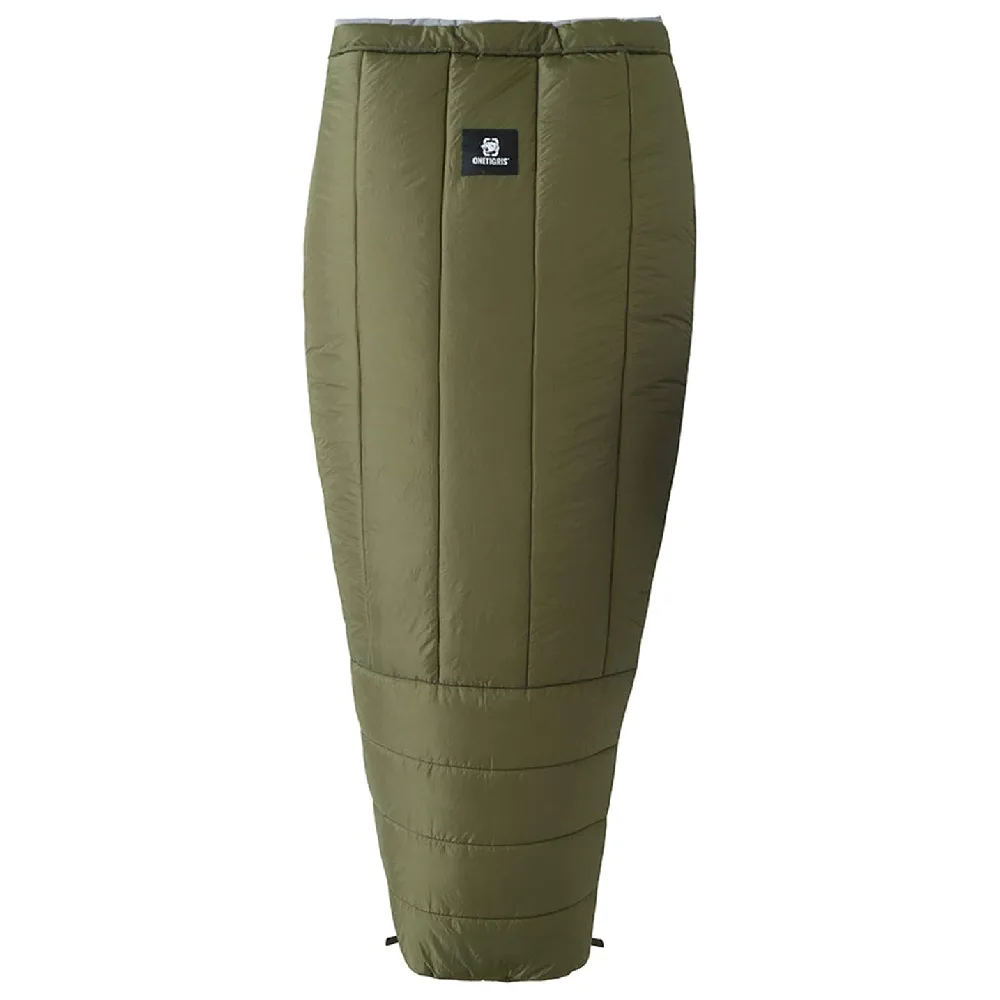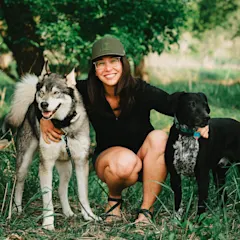We may earn revenue from the products available on this page and participate in affiliate programs. Learn more ›
Before testing backpacking quilts, I didn’t understand what the hype was about. Anytime someone mentioned one, I always thought, “Can’t I just use a sleeping bag? What’s the difference?” Turns out there is a difference, and if you give quilts a shot, you may be converted.
Here’s what sets them apart: Backpacking quilts don’t have back fabric and don’t wrap around your body like a sleeping bag. However, well-designed quilts still have excellent insulating and heat retention properties because they attach to a sleeping pad to hold them in place. Many lightweight and ultralight backpackers prefer quilts because, without a zipper and with less fabric, the sleep system is much lighter. Plus, for people like me who toss and turn or who sleep on their side or stomach, a quilt gives you more mobility and, in turn, a better night’s sleep. Below are the best backpacking quilts I tested for almost any condition.
Best Overall: Outdoor Vitals StormLoft Down TopQuilt
Best Ultralight: Big Agnes Fussel UL Quilt
Best Water-Resistant: Therm-a-Rest Vesper 32 Down Quilt
Most Versatile: Feathered Friends Flicker UL Quilt Sleeping Bag
Best Budget: OneTigris Featherlite Ultralight Sleeping Quilt
Best Overall: Outdoor Vitals StormLoft Down TopQuilt
Specs
Weight: 23 oz (15F Regular)
Fabric: 10D Ripstop Nylon w/ VitalDry DWR
Fill: 800-Fill Power HyperDry Water Repellent Down
Temperature Rating: 0 to 30F / -17 to -1C
Pros
Lightweight and highly packable
Available in a range of temperature ratings
Excellent water resistance for down
Clips and pad straps included
Outdoor Vitals lifetime warranty
Cons
Draft collar cinch is in a weird spot
The Outdoor Vitals StormLoft Down TopQuilt is one of the best three-season backpacking quilts in terms of value and performance. It is reasonably priced, especially when compared to similarly rated blankets and bags. I tested the StormLoft 15F for this article, but Outdoor Vitals also offers this design in a 0F and 30F temperature rating. If you get cold easily, even when camping in the summer, the 15F bag is an excellent option.
Outdoor Vital’s slogan is “live ultralight,” and this quilt lives up to that standard. The bag itself has a highly durable design yet is still very lightweight. Utilizing 800+ down fill and 10D fabric shell/lining, this bag is warm enough for most three-season ventures and should last several seasons. I like that the brand provides clear care instructions for cleaning online to help you maintain the blanket. The regular length of the quilt is suitable for most average adults, but each temperature rating comes in an extended version if that is a better fit.

The foot box of the quilt mimics that of a mummy bag, and the draft collar can help retain more body heat. If you’re camping in colder weather and worried about losing heat through your head, we suggest looking into the insulated balaclava that acts as a mummy hood would. It’s likely not necessary during the summer but it may enhance your sleep experience during cooler weather. While most features are suitable for a comfortable night’s rest, the cinch on the draft collar is in the middle of the quilt, which means it falls right onto your face when it is cinched down. If you’re a light sleeper, this may disturb you while you rest. There are clips and pad straps included, but the pad straps could be more durable and secure.
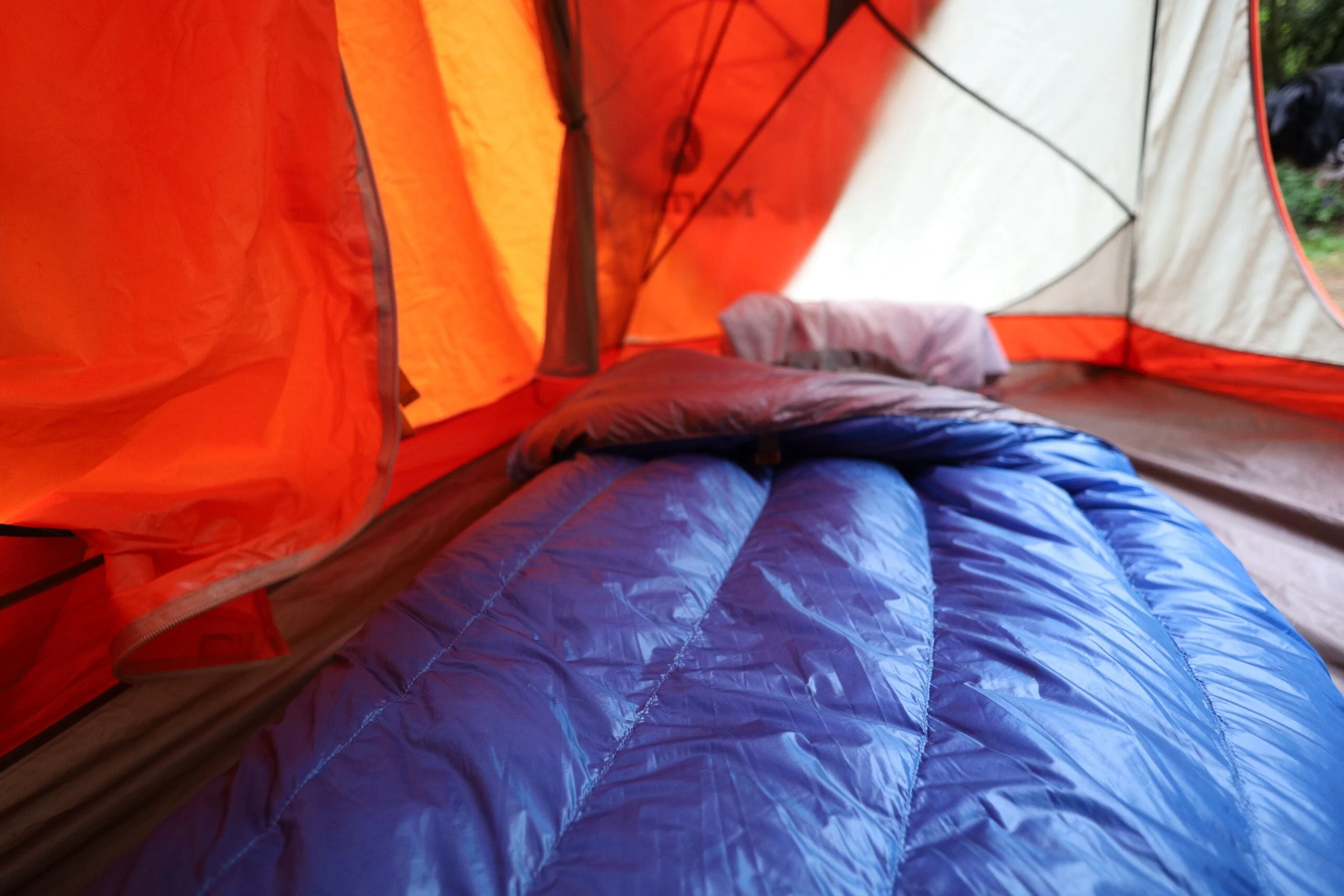
Note that quilts can be expensive, which is why many people don’t gravitate toward them—and even at a lower price point, this quilt may be out of some backpackers’ budgets. Other than that, there’s a lot to like about this quilt. It is an excellent value for the price, and the features suit backpackers and ultralight packers alike.
Best Ultralight: Big Agnes Fussel UL Quilt
Specs
Weight: 17.3 oz
Fabric: Polyester ripstop shell w/ water-repellent finish
Fill: 850 DownTek (PFAS-free)
Temperature Rating: 40F / 4C
Pros
Ultralightweight, minimalist design
Highly packable
Excellent material quality
Good value for the price
Cons
Only suitable for warm, casual camping
Sizing isn’t very inclusive
If ultralight is your goal, the Big Agnes Fussel UL Quilt should be a top consideration. This quilt packs and feels similar to ultralight camping blankets. The lightweight snapping system and minimal insulation provide a cozy night’s sleep but only under the right conditions. This quilt is great for casual camping or mid-summer ultralight trips. Weighing just around 1 pound, it’s an easy way to cut some pack weight on long hikes.
This quilt is so light because it is only rated for use at 40F, and it is insulated with 9 ounces of 850 down fill. This design can be functional but only for a short window of time or if you live in a sub-tropical climate. This limits its overall versatility, but you could use it as as more packable alternative to a sleeping bag liner for warmer summer camping trips. The snaps allow you to attach it to your sleeping pad or add some additional ventilation. Honestly, if it is that warm out, this works best opened as a blanket. Then, when temperatures are creeping down to the comfort rating, you can attach it to a higher r-value sleeping pad for just enough warmth overnight.
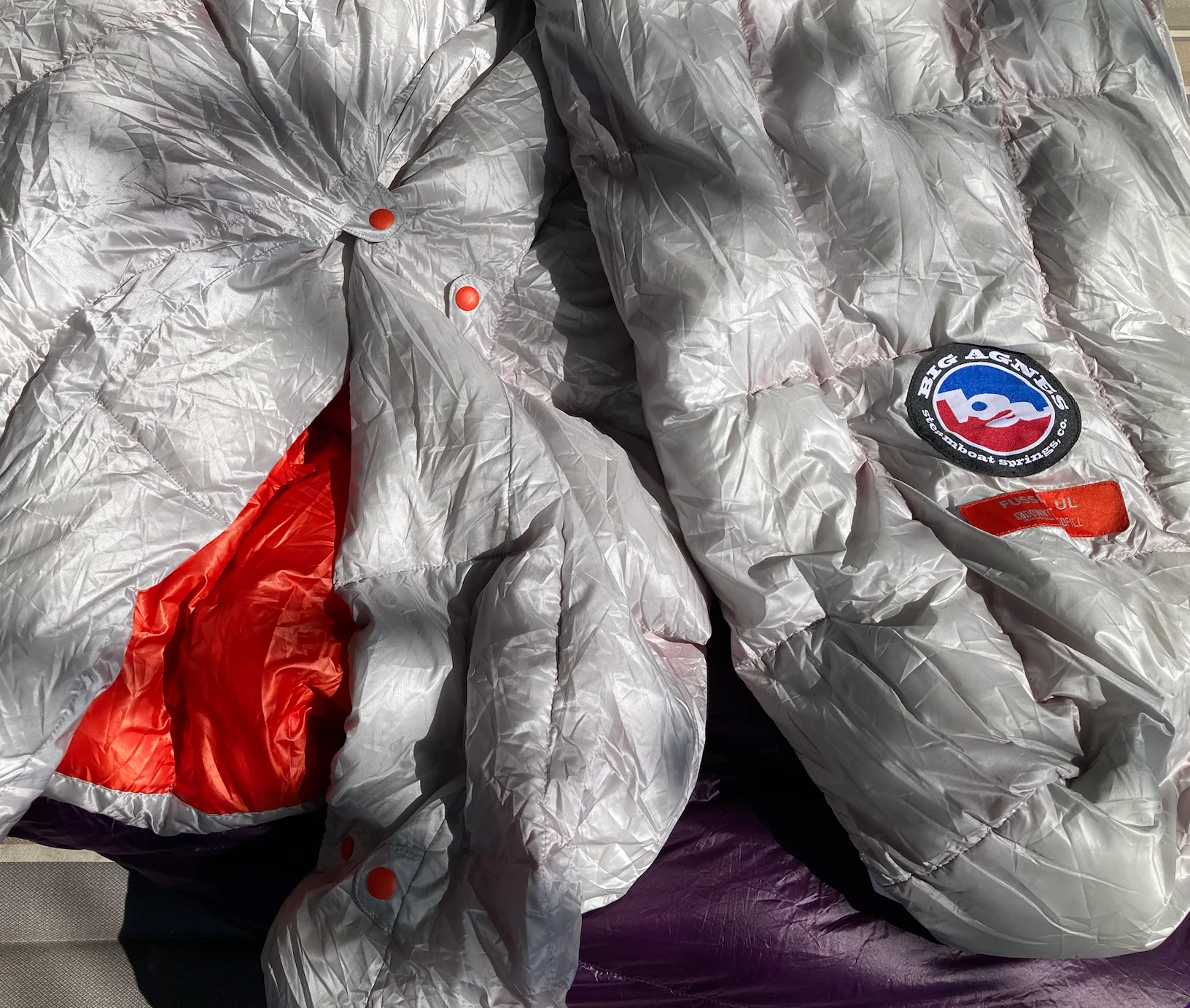
Another option for this quilt is to use it to layer and add extra insulation to existing sleep systems. That way, you have a quality summer bag to bolster your shoulder and winter-season equipment. The only design flaw I found with this bag is that because the snaps are so lightweight, they don’t secure very firmly. When I was shifting and moving around in the night, the snaps either opened up the bag or came unclipped from the pad attachment, which can compromise comfort while sleeping.
Best Water-Resistant: Therm-a-Rest Vesper 32 Down Quilt
Specs
Weight: 15 oz (Regular)
Fabric: 10D Nylon Ripstop w/ DWR
Fill: 900 Fill Goose Nikwax Hydrophobic Down, RDS
Temperature Rating: 32 F / 0 C
Pros
PFAS-free water-resistant down
Down sourced with the Responsible Down Standard
Lightweight and packable design
Durable materials
Comfortable shape and feel
Cons
Sleeping pad attachment can be improved
Down is an excellent insulator, but only if it is kept dry. When backpacking in remote areas, it’s tough to stay completely dry, and when things happen, you want your camping gear—especially essential gear like a sleeping bag or quilt—to work. Waterproofing down and other sleep materials can be difficult, but Therm-a-Rest pulled it off with their Nikwax Hydrophobic Down (RDS). The big benefit of Nikwax is that it’s PFAS-free, making it a highly functional waterproofing agent without harmful chemicals.
Beyond the practical performance in water resistance, the Therm-a-Rest Vesper Down Quilt is lightweight and comfortable. The design is standard for a quilt with a tapered end similar to a mummy bag and snaps to attach to your sleeping pad. Much like our ultralight pick, this quilt is only suitable for warm summer weather and is rated for 32F. Plan accordingly if it might be colder, mainly because the snaps and pad straps come loose fairly easily and could be updated for a more secure fit.
Most Versatile: Feathered Friends Flicker UL Quilt Sleeping Bag
Specs
Weight: 1 lb 9.2 oz (20F Regular)
Fabric: Pertex Endurance UL, Flite 15 denier ripstop nylon
Fill: 950+ Goose Down
Temperature Rating: 20 – 40F / -6.67 – 4.4C
Pros
Made in the USA
Available in three temperature ratings
Highly versatile design
Water-resistant shell fabric
Durable material construction
Cons
Not a fan of the neck draw cord for the closure and durability
The Feathered Friends Flicker UL Quilt Sleeping Bag can function as both a backpacking quilt and an ultralight sleeping bag. The option to use it as a full mummy bag or a quilt/blanket makes this one of the most functional and versatile sleep systems available. Made in the USA in Seattle, the down backpacking quilt is available in three temperature ratings. While the 40F bag is ideal for warm summer camping trips, I recommend the 20F quilt if you’re looking for something you can use across all seasons.
The benefit of a zipper gives this quilt an edge over the others because you can zip it up on colder nights to make it draft-free. Other quilts may cut a few ounces by avoiding this, but depending on when and where you’re backpacking, it may be well worth the additional weight. The zipper and drawcord on the neck collar and foot box provide extra ventilation and customization for sleeping conditions. You can cinch the neck collar up like a mummy bag hood or unzip it to wear as a quilt. Since it unzips fully, it also works well as a blanket.
The attention to design that went into this quilted bag blows me away with its versatility and functionality. The shell material is Pertex Endurance UL which is naturally water-resistant and won’t wear off over time, unlike coatings like DWR. There’s a lot to like with this quilt, and honestly, it was hard for me to find a con to list in this review. The only downside I can think of is that over time, the drawstrings loosen.
Best Budget: OneTigris Featherlite Ultralight Sleeping Quilt
Specs
Weight: 2 lbs
Fabric: 20D Ripstop Nylon, 380T Polyester Pongee Lining
Fill: SEE Polyester
Temperature Rating: 41F / 5C
Pros
Affordable price
Good for summer camping
Packs down small for a synthetic insulation
Hook and loop closure stays in place well
Cons
The loft of insulation can be lost in the compression bag during shipping
Only suitable for warm weather camping
Heavy for a backpacking quilt
If you want to try out a quilt but want to avoid paying a premium price, the OneTigris Featherlite Ultralight Sleeping Quilt is a decent place to start. It packs down small but because it utilizes synthetic insulation, it’s bulkier and heavier than down. However, the advantage of synthetic insulation is that it is easier to restore the loft if lost, and it continues to insulate when wet.
In the end, it is a functional quilt. Since it’s only rated for around 41F, we only recommend using it during warm summer nights. This cuts down on the functionality of the quilt for the entire backpacking season in most areas, but at this price point, it may be worth it, depending on your intended frequency of use. In the long run, you may be better off finding a better brand from a used retailer or local consignment store, but this one will do in a pinch.
How We Tested Backpacking Quilts

Choosing the best backpacking quilts was a new challenge for me. I have traditionally gravitated towards sleeping bags, especially since I do a lot of backpacking in the shoulder seasons or during cold weather. When beginning my research for this article, I didn’t know much about quilts or why they existed, so it was fun to learn more about the concept behind their design and see how genuinely functional they can be.
It took a fair amount of time to gather recommendations from backpackers who regularly use these products to determine which quilts to include in this article and which to test. As many of the hikers I interviewed are ultralight enthusiasts, they were able to point me in the right direction. From there, I collected the products and hit the trail. Being new to the quilt concept, I was particular about the heat retention and functionality as a part of my sleep system.
Beyond that, much of the testing looked similar to sleeping bags. I analyzed the weight and packability, the materials and sourcing, and I did my best to gauge durability. Like sleeping bags, no one quilt is the perfect fit for everyone. Each one has its best application, and like with most gear, it all comes down to personal preference and intended purpose.
What To Look for in a Backpacking Quilt
Backpacking Quilt vs. Sleeping Bag: What’s Right for You
From the outside looking in, it can be hard to tell why a quilt may be more beneficial than a sleeping bag in some situations, but for many thru-hikers and ultralight backpackers, a quilt is well worth the price. When deciding if a backpacking quilt is a good choice for your outdoor needs, it helps to know why quilts are designed the way they are.
Looking at a mummy sleeping bag, a quilt removes a few things to reduce weight and improve packability, namely the back of the sleeping bag. When laying on a sleeping bag, you compress the insulation. This compression nullifies any insulating properties, so a quilt won’t have a panel. Most quilts also remove the hood that is classically seen on mummy sleeping bags, but some have features or accessories that replicate a hood.
Since there is no back panel of fabric and insulation on a quilt, it can be draftier than a sleeping bag. That’s why a proper attachment system involving clips and pad straps is necessary to secure the quilt to your sleeping pad. While sleeping pads add some comfort while you sleep, its primary purpose is to insulate your body heat from the cold ground, so pairing your backpacking quilt with a properly rated sleeping pad is essential.
Most quilts are designed for warmer weather conditions and won’t be suitable for winter camping or even some high-altitude or shoulder season adventures. While many campers like the roominess quilts provide, they can be draftier than a sleeping bag depending on the pad attachment system and how much you move around at night. The potential drafting can deter backpackers because the temperature ratings on quilts are not necessarily as consistent as they would be for a sleeping bag.
While some quilts—like the Feathered Friends quilt—have a partial or full zipper, it’s less common. Removing features like a zipper and a hood is part of how quilt designs cut weight.
When choosing between a backpacking quilt and a sleeping bag, it is important to identify your intended use, the climate, and your sleeping style. If you’re an ultralight backpacker who mostly camps during the warm summer months, a quilt can be the perfect addition to your sleep system. If you’re like me and often backpack in cold weather, a mummy sleeping bag is the better choice.
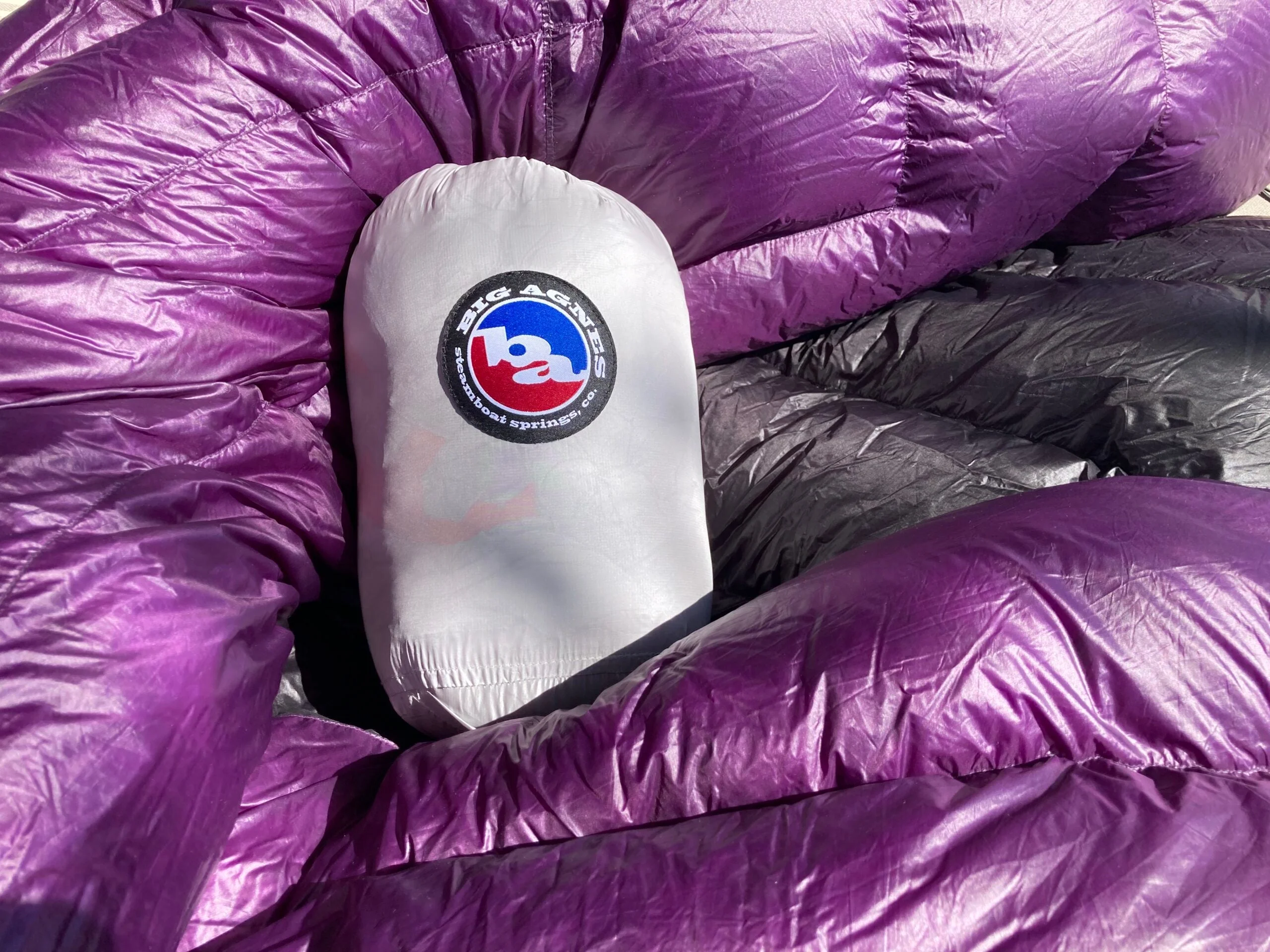
Temperature Rating
The temperature ratings for backpacking quilts are not the most consistent or reliable. While companies can use international testing standards like EN or ISO ratings, many brands do in-house testing and provide temperature ratings. Quilts often won’t qualify for international or standardized tests because of their open-back designs and potential for drafts.
Since the EN or ISO ratings for temperature are not always the most accurate, it is often better to look at a comfort rating or even the down-fill power and weight of the insulation to get an idea of how warm the quilt is. Other features that can increase the comfort rating include the option for a hood, a draft collar, a close foot box, and secure pad attachments.
The down fill power—which dictates how much space is filled per cubic inch by the down insulation—is essential when overviewing backpacking quilt specifications. For sleeping bags and quilts, fill power varies from 500-900, but many quilts sit on the higher end of the scale (850-950). It’s important to note that a higher fill power doesn’t always mean a warmer quilt. In junction with the fill power, look at the insulation weight to better understand the potential warmth. Fill weight isn’t as widely discussed but may be a better indicator than the fill power. Additionally, I recommend looking for duck and goose down sourced using the Responsible Down Standard.

It’s better to rely more on the comfort rating when comparing temperature and comfort ratings. Temperature ratings are generally listed as lower than the comfort rating because, as the name suggests, a comfort rating tells you the lowest temperature at the quilt keeps you comfortable. A temperature rating, on the other hand, is the lowest temperature at the bag keeps you safe. Comfort ratings are more common on women’s specific bags since the way women regulate body temperature is different than men’s.
In practice, I like to plan a sleep system colder than what you need, according to the forecast. This may be less of a concern in the summer, but if I am backpacking in a shoulder season and the nighttime low temperature is 30F, I bring either a 20F bag or lower. If that is not possible and I have a 30F bag, I pack a sleeping bag liner to improve the temperature rating.
Having a sleeping pad appropriate for the weather conditions can also increase your comfort as you sleep.
Materials and Water Resistance
Durability is a significant question with ultralight backpacking gear, and quilts are more than likely less durable than the average sleeping bag. To gauge the potential durability of the bag, consider the materials used for the shell fabric and the fabric denier. Product specifications list the product materials and may have a number with a D next to it. The D stands for denier, the thread thickness used to make the fabric. The higher the denier number, the more durable the fabric is.
Even fabrics with a relatively high denier are prone to rips and tears, so proper care is recommended while using quilts on the trail. Be aware of sticks and rocks when setting up camp, and store the quilt out of the compression bag to preserve the insulation loft.
Quilt liner and shell material are typically made from some synthetic material or blend. Materials like ripstop nylon are common, but some brands may use proprietary fabric blends to create a more water-resistant and durable material.
To save weight, most backpacking quilts strictly utilize down insulation. Although down is much lighter and can pack down smaller than synthetic insulation, it doesn’t continue to insulate when wet. This may not be as much of an issue in warm conditions, but it can mean sacrificing some comfort on the trail. To combat these issues, many companies now integrate some form of water resistance into their down insulation. Big Agnes utilizes DownTek waterproofing, while Therm-a-Rest opts for a PFAS-free solution from Nikwax.
Weight and Portability
The intention behind the backpacking quilt design is to be highly packable and lightweight, so I recommend picking one that weighs 2 lbs or less. Many of the quilts listed here are best suited for warm weather conditions, which helps them stay lightweight.

If your sleeping bag’s weight and packed size are the primary considerations, a backpacking quilt is recommended. Many average campers gravitate towards bags instead because they tend to have a higher level of comfort and durability. All ultralight gear has some trade-offs, and with quilts, the most significant sacrifice you’re likely to make is regarding the temperature rating and the high likelihood of a draft.
FAQs
Q: What is the advantage of using a backpacking quilt instead of a sleeping bag?
The primary benefit of a backpacking quilt is that they are lighter than a traditional sleeping bag. On average, a quilt is around 25% lighter than a sleeping bag because much of the fabric that’s usually under the sleeper is eliminated. Most backpacking quilts attach to the sleeping pad to stop any significant heat loss, and since compressed down and synthetic insulation doesn’t insulate properly, their performance is comparable to sleeping bags.
Q: Can you use a backpacking quilt for winter camping?
A backpacking quilt with an appropriate temperature and comfort rating for the conditions can be used for winter camping. Since most quilts don’t utilize zippers, they’re easier to get in and out of than zippered sleeping bags. If heat loss due to the lack of a zipper is a concern, layering insulating clothing to cover drafts or adding another quilt is always an option.
Q: What is the best material for a backpacking quilt?
The best material for a backpacking quilt combines a durable synthetic shell and lightweight, high-fill power-down insulation. Most of the highest-performing backpacking quilts utilize duck or goose down, certified through the Responsible Down Standard. Some quilts may also utilize a hydrophobic down to increase moisture resistance and drying times if materials get wet.
Q: Are backpacking quilts good for side sleepers?
Backpacking quilts are great for side sleepers, stomach sleepers, and anyone who tosses and turns a lot in their sleep. While you may get a similar effect with an unzipped sleeping bag, the big difference is that most quilts can attach to the sleeping pad. That way, you don’t catch a draft from the bag moving too much while you sleep.
Final Thoughts
The best backpacking quilts are lightweight, comfortable, and highly packable. It is safe to say that backpacking quilts are not for everyone, especially at their average price point. However, they can be an invaluable piece of camping equipment for ultralight backpackers or anyone that moves a lot in their sleep. Get to know how and when you may use a backpacking quilt before investing in one. Once you’ve tried a well-designed quilt, you may have a hard time going back to always using a sleeping bag.
Why Trust Us
For more than 125 years, Field & Stream has been providing readers with honest and authentic coverage of outdoor gear. Our writers and editors eat, sleep, and breathe the outdoors, and that passion comes through in our product reviews. You can count on F&S to keep you up to date on the best new gear. And when we write about a product—whether it’s a bass lure or a backpack—we cover the good and the bad, so you know exactly what to expect before you decide to make a purchase.

